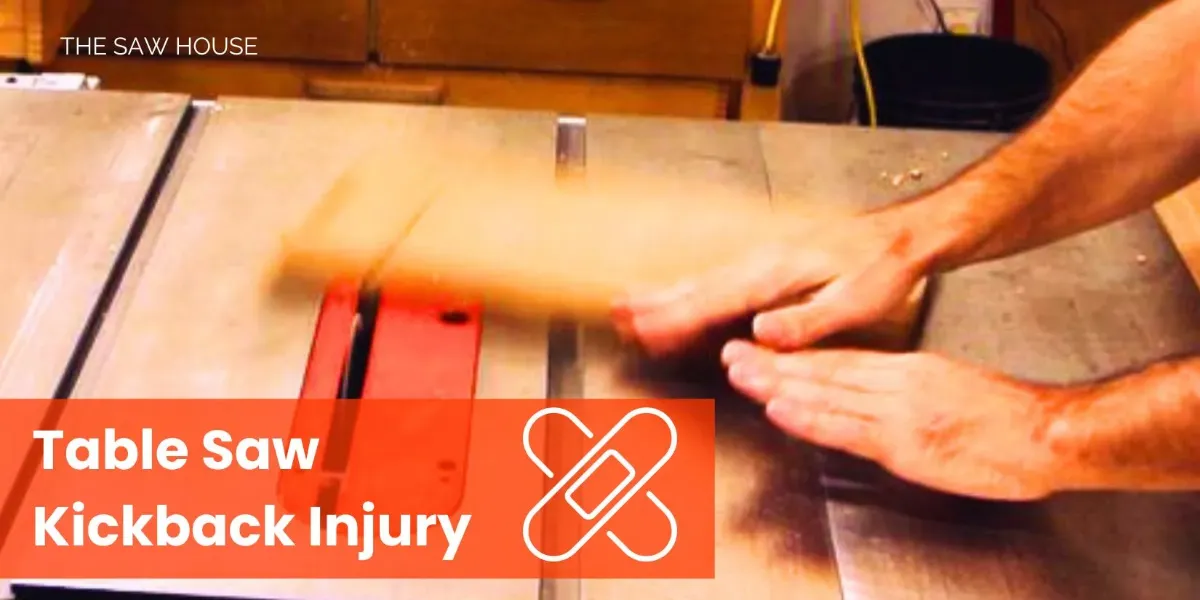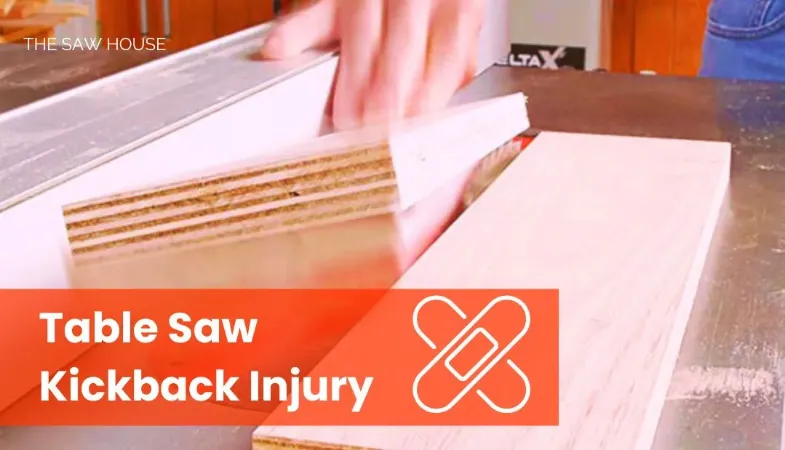If you’re a woodworker, you know the importance of using a table saw. However, when you’re not careful, you can be injured by the kickback. That can occur when the saw blade ejects material from the workpiece.

Table Saw Kickback Injury
Table saw kickback can occur when the table saw’s blade comes into contact with an object that is not being cut. This can happen if the object is in the path of the blade.
Also, if the operator is not paying attention and allows the blade to contact the object.
When this happens, the force of the kickback can cause the object to be ejected from the saw at high speed.
This can be extremely dangerous and result in severe injury or even death.
The Causes Of Table Saw Injury?
Several different things that can cause table saw kickback. In the list below, we will identify and explain some of the more common causes:
Unsecured Workpiece
If the workpiece is not adequately secured to the table saw, it can move around while the blade is cutting.
This can cause the blade to come into contact with the workpiece and kick it back.
For this reason, a table saw injury can happen. So, always ensure your workpiece is properly secured before starting the cut.
Wrong Blade For The Material
Using the wrong blade type for the cut material can also cause kickback.
For example, using a circular blade on a table saw can cause the material to be ejected from the saw at high speed.
Besides, using a rip blade to cut plywood can cause the plywood to splinter and kick back. Moreover, the dado blade can also cause severe kickback.
So, it would help if you always used the correct blade type for your cutting material.
Kicking Back While Cutting
Another common cause of table saw kickback is when the operator kicks back while cutting.
This can happen when you are not paying attention and allow the blade to contact the object.
If this happens, the force of the kickback can cause the object to be ejected from the saw at high speed. It can be hazardous and result in severe injury or even death.
Dull Blade
A dull table saw blade can cause kickback because it can get stuck in the workpiece.
When this happens, the operator may try to force the blade through the workpiece. Which can cause the workpiece to be ejected from the saw.
It would be best if you always kept your table saw blade sharp to avoid this kickback. Try to sharpen the blade before each use.
Improper Blade Guard
The kickback guard is designed to prevent kickbacks from occurring.
However, if the table saw is not equipped with a blade guard or if the guard is not installed correctly. It can cause the blade to come into contact with the workpiece.
This can result in a kickback. You don’t have to worry about this problem with a proper blade guard.
Avoiding Table Saw Kickback Injury
Now that we know what can cause table saw kickback. Let’s take a look at how to avoid getting injured by it.
There are several things you can do to avoid this dangerous situation. Below we will list some of the more effective methods:

Have Essential Safety Features In Place
When using a table saw, always ensure it has all the essential safety features. These features include a riving knife, anti-kickback pawls, and a blade guard.
A riving knife is placed behind the blade and prevents kickback from occurring.
The anti-kickback pawls are on either side of the blade and help prevent the workpiece from being ejected from the saw.
The blade guard is placed over the blade and helps to protect you from injury if kickback occurs.
Use The Proper Technique
If you are using a table saw, always use the proper technique. This means holding the workpiece firmly and ensuring that your hands are not in the blade’s path.
You should also never try to force the blade through the workpiece.
If you find that the blade is getting stuck, stop cutting and unplug the saw before trying to remove the blade.
On the other hand, if you use a rip blade, always use a push stick to keep your hands away from the blade.
Pay Attention To What You Are Doing
It is essential to always pay attention to what you are doing when using a table saw.
If you are not paying attention, you can easily make a mistake that could result in a kickback. Always be sure to focus on your work and never allow yourself to be distracted.
If you need a break, unplug the saw and wait until you are ready to focus again before starting to cut.
Use The Proper Blade
Always use the right blade for the material you are cutting. As we mentioned before, using the wrong blade type can cause kickback.
If you are not sure which blade to use, ask someone at your local hardware store for help.
For example, when cutting softwood, use a blade designed for softwood. But if you are cutting hardwood, then use a blade designed for hardwood.
Don’t Use A Dull Blade
As we mentioned before, using a dull blade can cause kickback. This is because the blade can get stuck in the workpiece.
To avoid this, be sure to keep your table saw blade sharp. You can do this by either sharpening the blade or replacing it with a new one.
Follow the manufacturer’s instructions carefully if you choose to sharpen the blade. Otherwise, you could damage the blade.
Use A Push Stick
When cutting, always use a push stick. This will help keep your hands away from the blade and prevent kickback.
A push stick will keep your hands at a safe distance from the blade. You can rest assured that your hand will not be drawn into the blade if kickback occurs.
A push stick also serves as a kickback prevention technique because it allows you to exert more control over the stock.
Do not Crosscut with the Rip Fence
While the rip fence is a great safety feature, you should never use it to crosscut. The blade can become caught in the workpiece and cause kickback.
Use a miter gauge or a crosscut sled if you need to crosscut.
On the other hand, when cutting a piece of wood, always ensure the rip fence is not in the way. If it is, you could end up with a kickback.
The best way to avoid this is to use a crosscut sled. A crosscut sled will allow you to make cuts without the rip fence getting in the way.
Never Make Free-Hand Cuts
Free-hand cuts are when you cut without using a guide.
This is extremely dangerous and should never be done. That’s why you should always use a guide of some sort.
This could be a miter gauge, a fence, or a sled. All table saws have a fence, so there is no excuse not to use one. A guide will help keep the blade in line and prevent kickback.
So, there you have it. These are just a few tips to help prevent kickbacks. Remember, kickbacks can happen anytime, so it is crucial to always be aware of your actions.
And if you ever find yourself in a situation where kickback does occur, be sure to unplug the saw and wait for the blade to come to a complete stop before attempting to remove it from the workpiece.
FAQs
What Is The Most Common Cause Of Table Saw Injuries?
The most common cause of table saw injuries is kickback. Kickback can occur when the blade comes into contact with an object that is not being cut.
How Does Kickback Happen On A Table Saw?
Several different things can cause kickback on a table saw. The most common cause is when the workpiece is not adequately secured to the table saw.
What Is An Anti-Kickback Pawl?
An anti-kickback pawl is a device that is designed to help prevent kickback. It is usually located near the blade behind the table saw.
Final Thoughts
Kickbacks are the number one cause of table saw accidents.
It is crucial to always be aware of what you are doing and to use the proper safety precautions. If you follow the above tips, you can help prevent kickbacks.
We hope that now you know about table saw kickback injury prevention and feel confident about using your table saw.
Resources: https://www.fs.usda.gov/about-agency/regulations-policies/saw-policy
